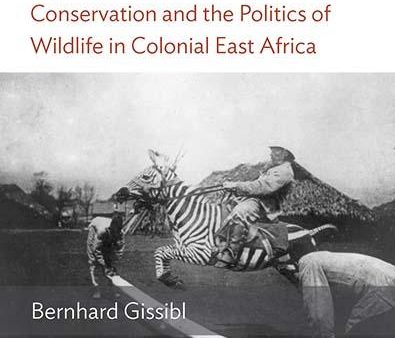
The Nature of German Imperialism: Conservation and the Politics of Wildlife in Colonial East Africa by Bernhard Gissib
 In modern Tanzania, spaces protected for forest and wildlife conservation make up 29 percent of the landscape. 13 percent of the country is set aside for national parks and game conservation areas to cater especially to a modern tourist industry, which seeks to draw in nature consumers to view and hunt African wildlife. Bernhard Gissibl’s, The Nature of German Imperialism: Conservation and the Politics of Wildlife in Colonial East Africa is the first comprehensive treatment of the origins of big game hunting, national parks, wildlife reserves, megafauna protection, and even “safari tourism” under German colonial rule (1885 to 1918) in the former German East Africa. Although Gissibl is wrong that the topic has been completely ignored in past histories, often exaggerates the novelty of his findings and ideas, and does not always attribute their provenance, this study is likely to be the authoritative account of German measures aimed at wildlife (especially elephant) conservation in its East African colony for the foreseeable future. His use of primary sources from multiple archives, as well as contemporary published sources, and modern scholarly works on the topic of wildlife conservation is impressive. That said, a topic as immense as this always leaves room for further exploration.
In modern Tanzania, spaces protected for forest and wildlife conservation make up 29 percent of the landscape. 13 percent of the country is set aside for national parks and game conservation areas to cater especially to a modern tourist industry, which seeks to draw in nature consumers to view and hunt African wildlife. Bernhard Gissibl’s, The Nature of German Imperialism: Conservation and the Politics of Wildlife in Colonial East Africa is the first comprehensive treatment of the origins of big game hunting, national parks, wildlife reserves, megafauna protection, and even “safari tourism” under German colonial rule (1885 to 1918) in the former German East Africa. Although Gissibl is wrong that the topic has been completely ignored in past histories, often exaggerates the novelty of his findings and ideas, and does not always attribute their provenance, this study is likely to be the authoritative account of German measures aimed at wildlife (especially elephant) conservation in its East African colony for the foreseeable future. His use of primary sources from multiple archives, as well as contemporary published sources, and modern scholarly works on the topic of wildlife conservation is impressive. That said, a topic as immense as this always leaves room for further exploration.
Gissibl centers the role of elephants and the ivory trade in his study. Elephants were unquestionably the most charismatic and economically important of East African wildlife for most of its history. The first chapter details the pivotal role that ivory procurement and elephant hunting had in the “pre-colony” of German East Africa.
Ivory was the most valuable export commodity from the mainland throughout the nineteenth century, drawing in traders and freebooters who put the region on the radar of European imperialists.
Ivory was the most valuable export commodity from the mainland throughout the nineteenth century, drawing in traders and freebooters who put the region on the radar of European imperialists. Many of Gissibl’s arguments—the importance of the “ground tusk” principle to many East African societies, the introduction of firearms on a large scale to facilitate hunting, the emergence of African “big men” to monopolize the ivory trade locally, and the importance of introduced commodities, especially cotton cloth, in societal formation—will be familiar to historians of East Africa. Here Gissibl’s most innovative contribution is the insight that early German colonial rulers usurped the African ancestral “ground tusk” right as a means to establish their own political and even ritual authority over the land, demanding one tusk from each felled elephant, and building early colonial wildlife conservation around this claim. As chapter two details, ivory was far too valuable a commodity to neglect in the building of German colonialism, so officials did their best to enlist the alliance and support of local chiefs and big men to control elephant hunting and channel ivory revenues into administrative coffers. Most wildlife conservation was innovated by German “men on the spot” whose pressing concern was local stability during the conquest decade of the 1890s. This decade saw the first colonial forays into the establishment of game reserves and hunting licenses in East Africa. Gissibl adapts Richard White’s concept of “middle ground” to explore the negotiations and accommodations that took place between local officials, African chiefs, and elephant hunters directed at the provision of “fiscal ivory.” In so doing, he disputes my argument that the advent of German colonialism represented a clash of hunting cultures—German sport hunting on one side, and African hunting of valuable game for profit and predators to protect crops and people on the other. Yet Gissibl subscribes to my view that Maji Maji—the great African uprising against German colonial rule from 1905-07—was sparked in large part owing to African loss of ecological control owing to the encumbrances of German hunting (and forest) reserves, hunting laws, and proscriptions of firearms that endangered local societies and motivated elephant hunters to lead the rebellion. Here his main intervention is that Germans fought the war by relying on the same “middle ground” networks of elephant hunters and traders that, in fact, more often appeared on the side of rebels.
Following Maji Maji, as chapters four through six detail, wildlife conservation was complicated by an upsurge in white settlers, especially Germans and Afrikaners, who relied on hunting for sport and trading, but who also sought to protect their lands from crop marauders and disease-bearing animals that threatened livestock. They were allied in part by scientific experts, foremost among them 1905 Nobel prizewinner Robert Koch, who had begun to understand that wildlife were vectors of devastating livestock diseases such as bovine sleeping sickness and Rinderpest. The newly appointed governor, Albrecht von Rechenberg, believed that hunting curbs and wildlife destruction had been key motives for the Maji Maji rebellion, so worked to mitigate hunting laws to ease the wildlife burden on Africans in order to prevent another rebellion. To Rechenberg, wildlife protection, even in reserves, must not take precedence over settler and especially African agricultural advancement. Against him was pitted a panoply of transnational conservationists, some of whom had spent time in East Africa as trophy hunters, others who represented the German aristocracy with connections to the Kaiser. The 1900 London Conference on the Preservation of Wild Animals, Birds, and Fish in Africa, which included German planners and participants, called for an extensive infrastructure of wildlife reserves in the colonies to protect valued game, making their hunt the exclusive right of elite, white, non-resident hunters able to purchase expensive licenses and pay shooting fees—a model already in effect in neighboring Kenya, a British colony at the forefront of promoting safari tourism and big game hunting. Gissibl agrees with past scholarship that has detailed how colonial hunting legislation by 1912 severely handicapped the African ability to control their environments by protecting fields and people from wild predators. The powerful conservationist lobby ultimately forced out Rechenberg, as Juhani Koponen first suggested, and strengthened laws against African and settler hunting, while extending the range of wildlife reserves. The expatriate conservationist promotion of the myth of a primeval, Edenic Africa found wide appeal among the German public, as it has globally in modern times. On the eve of World War I in German East Africa, some fifteen wildlife reserves encompassed about 3.7 percent of the landscape, an area larger than Belgium. Although it was impossible to police their borders completely (as in modern Tanzania), they nevertheless launched a continuous pattern of separating nature from human settlement that would grow under subsequent British and post-colonial rule. The creation of protected spaces for wildlife and nature, however imperfect, drew both on a European precedent of aristocratic hunting on private domains and the U.S. national park ideal that began with Yellowstone in 1872, even though the meaning and purpose of a ‘national park’ at this early date was still debated.
With an eye to modern international conservationism, chapter seven examines early Anglo-German efforts to set up trans-border wildlife reserves between British East Africa and German East Africa, an effort that ultimately failed owing to the threat of poaching, animal diseases, and local land conflicts, including competing interests of white settlers.
With an eye to modern international conservationism, chapter seven examines early Anglo-German efforts to set up trans-border wildlife reserves between British East Africa and German East Africa, an effort that ultimately failed owing to the threat of poaching, animal diseases, and local land conflicts, including competing interests of white settlers. These efforts, however, led to the aforementioned 1900 London Wildlife Conference, “a milestone in international environmentalism,” which, although never ratified, created precedents for transnational cooperation on limiting the size of elephant tusks that could be exported, thus protecting young elephants. The conference also put on the agenda a panoply of wildlife protection measures, especially wildlife reserves and hunting restrictions, which in the long run were broadly accepted in various African colonies, and which, Gissibl notes, created hardships for Africans on the ground. He underscores that international conservationism in the colonies belies past histories that see only nationalist rivalry during the era of European colonial rule in Africa. Yet it has long been noted that in matters of scientific interest, such as animal and human disease control, the colonial powers long cooperated in sharing knowledge and coordinating efforts.
Gissibl’s theme of transnationalism reappears in chapter eight with an examination of how representations of the colonial East African wildlife environment fed the imaginations of Germans in the metropole, influencing emergent environmentalist discourses. Images of African fauna, presented in slide shows, illustrated books, museum displays, and photographs, justified ongoing colonial rule to the German public as a kind of civilizing mission to protect supposedly pristine, wild spaces from surrounding African populations. Industrializing Germany by then lacked its own wild spaces and megafauna, and thus sought an antidote in the colonies. Propaganda campaigns for the preservation of African wildlife ultimately succeeded in forcing changes to hunting laws and the nature of wildlife reserves in German East Africa. They also foreshadowed post-World War II and post-colonial preservationist campaigns that used wildlife films as a vehicle to capture and shape the imaginations of the German and international public. An Epilogue surveys how, following World War I, German propagandists used a supposed German colonial wildlife preservationism as a claim for the return of the colonies, particularly under the National Socialist regime, positing Germany as the proper steward of the environment. In the interwar years, Germans began to return to Tanganyika as settlers, and, despite the interlude of World War II, a German interest in modern Tanzanian wildlife conservation has never abated. This was seen especially in the wildlife films and books of Bernhard Grzimek, who was most influential in shaping the modern national park ideal in Tanzania at the moment of independence in 1961. In recent decades, German conservationists have been active in Tanzania, promoting wildlife protection in cooperation with the Tanzanian state, which, to Gissibl, “means nothing less than the continuation of a century of wildlife ownership by the centralized state.”
Only occasionally do we get a sense in The Nature of German Imperialism of how German wildlife conservation policies affected Africans on the ground. There is no detailed study of how a particular game reserve, for example, affected Africans of a locality, and Gissibl believes that archival sources do not survive to retrieve such a history. I’m not sure that this is true; similar histories of forest reserves—some 250 in German East Africa by the end of German rule—can be told. It might take a recounting of African local history in proximity to wildlife reserves along the lines of Jan Bender Shetler’s account of western Serengeti communities, to do this. And, because many of these protected spaces have histories that went far beyond the loss of Germany’s colonies during World War I, a longer time frame would be necessary. Gissibl is interested in the big picture and broad themes of current historiographical interest, especially internationalism and transnationalism in modern conservation. The book is torn between detailing and even celebrating German colonial wildlife interventions as “the basis of Tanzania’s conservation complex,” and underscoring how illusory, contradictory, and even destructive much of it was.
Reviewed by Thaddeus Sunseri, Colorado State University
The Nature of German Imperialism: Conservation and the Politics of Wildlife in Colonial East Africa
by Bernhard Gissibl
Berghahn Books
Hardcover / 360 pages / 2016
ISBN 9781785331756
Published on January 5, 2017.




